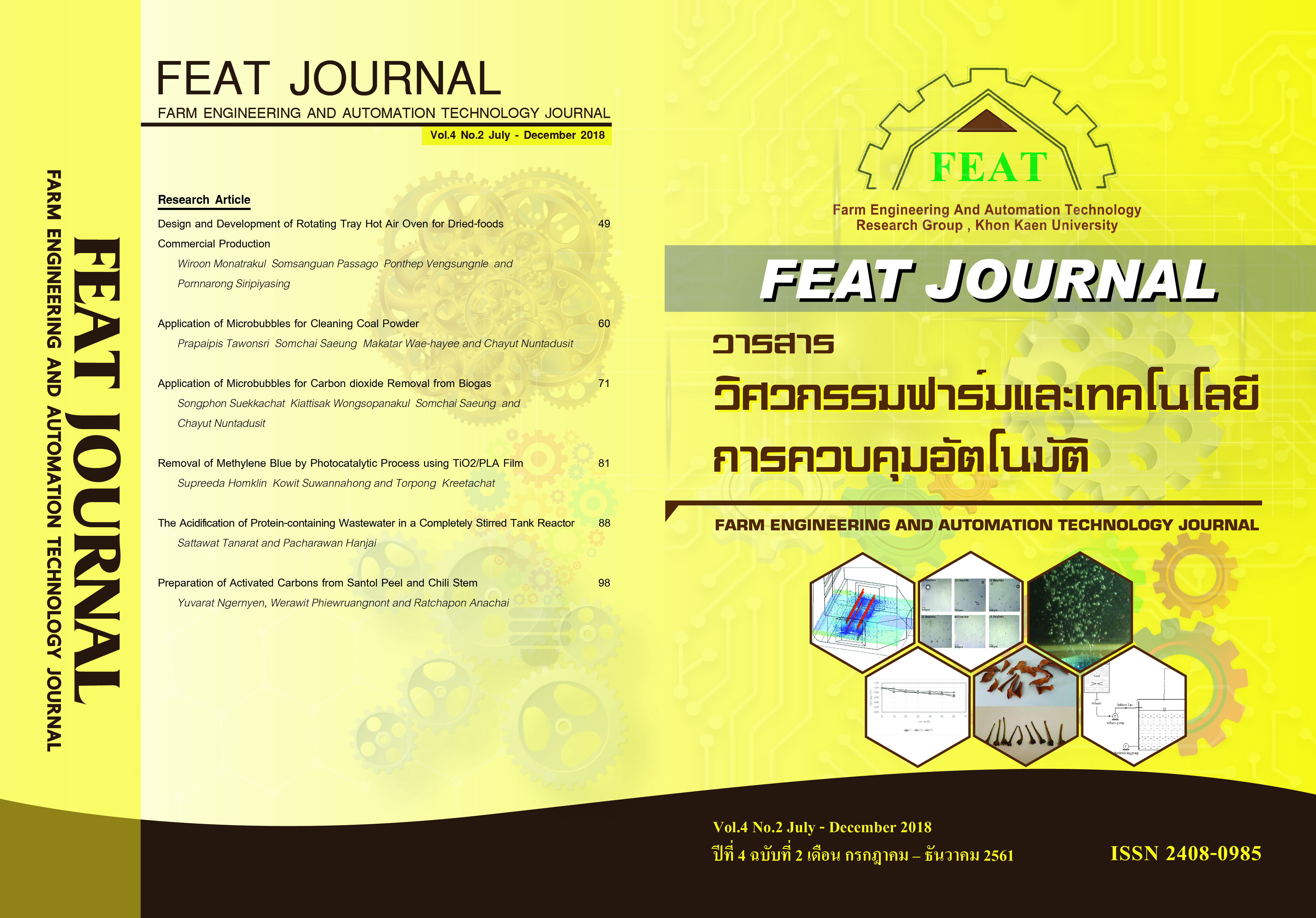ประสิทธิภาพการสร้างกรดของน้ำเสียสังเคราะห์ที่มีโปรตีนเป็นองค์ประกอบหลัก ในถังปฏิกิริยากวนสมบูรณ์
Main Article Content
บทคัดย่อ
การศึกษานี้ได้ทำการศึกษาการสร้างกรดของน้ำเสียที่มีโปรตีนเป็นองค์ประกอบหลักในถังปฏิกิริยากวนสมบูรณ์ (ซีเอสทีอาร์) น้ำเสียที่ใช้เป็นน้ำเสียสังเคราะห์ที่เป็นตัวแทนของน้ำเสียจากกระบวนการผลิตไอศครีม น้ำเสียจากกระบวนการผลิตผลิตภัณฑ์อาหารเสริม และน้ำเสียจากอุตสาหกรรมเวชสำอาง ที่มีค่าซีโอดีประมาณ 2,000 มก./ล. ถังปฏิกิริยาสร้างกรดเป็นถังปฏิกิริยาแบบซีเอสทีอาร์ระดับห้องปฏิบัติการขนาด 3 ลิตร เดินระบบแบบต่อเนื่องที่ระยะเวลากักเก็บน้ำเท่ากับ 4 ชั่วโมง อัตราภาระบรรทุกสารอินทรีย์ในช่วง 13.24-13.92 กก.ซีโอดี/ลบ.ม.-วัน ภายใต้สภาวะที่ไม่มีการควบคุมอุณหภูมิและค่าพีเอช จากการศึกษาพบว่า ประสิทธิภาพการสร้างกรดของน้ำเสียจากอุตสาหกรรมเวชสำอางมีค่าสูงสุด โดยมีร้อยละของการสร้างกรดและอัตราการสร้างกรดเท่ากับ 36.5% และ 4.8 กรัมซีโอดี/ลิตร-วัน ตามลำดับ รองลงมาคือน้ำเสียจากกระบวนการผลิตไอศครีม (30.2% และ 3.9 กรัมซีโอดี/ลิตร-วัน) และน้ำเสียจากกระบวนการผลิตผลิตภัณฑ์อาหารเสริม (10.8% และ 1.4 กรัมซีโอดี/ลิตร-วัน) ซีโอดีในน้ำเสียถูกเปลี่ยนให้เป็นก๊าซชีวภาพน้อยมาก สภาวะที่ใช้ในการศึกษานี้จึงมีความเหมาะสมต่อการสร้างกรดของน้ำเสียที่มีโปรตีนเป็นองค์ประกอบหลัก
Article Details
วารสารวิศวกรรมฟาร์มและเทคโนโลยีควบคุมอัตโนมัติ (FEAT Journal) มีกําหนดออกเป็นราย 6 เดือน คือ มกราคม - มิถุนายน และ กรกฎาคม - ธันวาคม ของทุกปี จัดพิมพ์โดยกลุ่มวิจัยวิศวกรรมฟาร์มและเทคโนโลยีควบคุมอัตโนมัติ คณะวิศวกรรมศาสตร์มหาวิทยาลัยขอนแก่น เพื่อเป็นการส่งเสริมและเผยแพร่ความรู้ ผลงานทางวิชาการ งานวิจัยทางด้านวิศวกรรมศาสตร์และเทคโนโลยีพร้อมทั้งยังจัดส่ง เผยแพร่ตามสถาบันการศึกษาต่างๆ ในประเทศด้วย บทความที่ตีพิมพ์ลงในวารสาร FEAT ทุกบทความนั้นจะต้องผ่านความเห็นชอบจากผู้ทรงคุณวุฒิในสาขาที่เกี่ยวข้องและสงวนสิทธิ์ ตาม พ.ร.บ. ลิขสิทธิ์ พ.ศ. 2535
เอกสารอ้างอิง
[2] Latif MA, Ghufran R, Wahid ZA, Ahmad A. Integrated application of upflow anaerobic sludge blanket reactor for the treatment of wastewaters. Water Research 2011; 45(16): 4683-4699.
[3] Chipasa KB, Medrzycka K. Behavior of lipids in biological wastewater treatment processes. J of Indian Microbiology Biotechnology 2006; 33(8): 635–645.
[4] Vidal G, Carvalho A, Méndez R, Lema JM. Influence of the content in fats and proteins on the anaerobic biodegradability of dairy wastewaters. Bioresource Technology 2000; 74(3): 231-239.
[5] Kim SH, Han SK, Shin SH. Two-phase anaerobic treatment system for fat-containing wastewater. J of Chemical Technology & Biotechnology 2004; 79(1): 63-71.
[6] Ke S, Shi Z, Fang HHP. Applications of two–phase anaerobic degradation in industrial wastewater treatment. Int J of Environment and Pollution 2005; 23(1): 65–80.
[7] Sponza DT, Demirden P. Treatability of sulfamerazine in sequential upflow anaerobic sludge blanket reactor (UASB)/completely stirred tank reactor (CSTR) processes. Separation and Purification Technology 2007; 56(1): 108-117.
[8] Yu Y. Research on soybean protein wastewater treatment by the integrated two-phase anaerobic reactor. Saudi J of Biological Sciences 2015; 22(5): 526-531.
[9] Vavilin VA, Fernandez B, Palatsi J, Flotats X. Hydrolysis kinetics in anaerobic degradation of particulate organic material: An overview. Waste Management 2008; 28(6): 939-951.
[10] Alkaya E and Demirer GN. Anaerobic acidification of sugar-beet processing wastes: Effect of operational parameters. Biomass and Bioenergy 2011; 35(1): 32-39.
[11] Rajagopal R and Beline F. Anaerobic hydrolysis and acidification of organic substrates: Determination of anaerobic hydrolytic potential. Bioresource Technology 2011; 102(10): 5653-5658.
[12] Oktem YA, Ince O, Donnelly T, Sallis P, Ince BK. Determination of optimum operating conditions of an acidification reactor treating a chemical synthesis-based pharmaceutical wastewater. Process Biochemistry 2006; 41(11): 2258-2263.
[13] Dinopoulou G, Rudd T and Lester JN. Anaerobic acidogenesis of a complex wastewater: The influence of operational parameters on reactor performance. Biotechnology Bioengineering 1988; 31(9): 958-968.
[14] Demirel B and Yanigun O. Anaerobic acidogenesis of dairy wastewater: the effects of variations in hydraulic retention time with no pH control. J of Chemistry Technology Biotechnology 2004; 79: 755-760.
[15] APHA. Standard methods for the examination of water and wastewater, 20th ed., American Public Health Association/American Water Works Association/Water Environment Federation, Baltimore: 1988.
[16] Metcalf and Eddy. Wastewater engineering: treatment, disposal and reuse, 4th ed, McGraw-Hill, New York: 2004.
[17] Guerrero L, Omil F, Mendez R and Lema JM. Anaerobic hydrolysis and acidogenesis of wastewater from food industries with high content of organic solids and protein. Water Research 1999; 33(15): 3281-3290.
[18] Maharaj I and Elefsiniotis P. The role of HRT and low temperature on the acid–phase anaerobic digestion of municipal and industrial wastewaters. Bioresource Technology 2001; 76(3): 191-197.
[19] Bengtsson S, Hallquist J, Werker A and Welander T. Acidogenic fermentation of industrial wastewaters: effects of chemostat retention time and pH on volatile fatty acids production. Biochemistry Engineering 2008; 40(3): 492-499.
[20] Reis MA, Serafim LS, Lemos PC, Ramos AM, Aguiar FR, Van Loosdrecht MC. Production of polyhydroxyalkanoates by mixed microbial cultures. Bioprocess Biosystem Engineering 2003; 25(6): 377-85.
[21] Albuquerque MG, Eiroa M, Torres C, Nunes BR, Reis MA. Strategies for the development of a side stream process for polyhydroxyalkanoate (PHA) production from sugar cane molasses. J of Biotechnology 2007; 130(4): 411-21.
[22] Bengtsson S, Werker A, Christensson M, Welander T. Production of polyhydroxyalkanoates by activated sludge treating a paper mill wastewater. Bioresource Technology 2008; 99(3): 509-16.
[23] Krasnits E, Beliavsky M, Tarre S, Green M. PHA based denitrification: Municipal wastewater vs. acetate. Bioresource Technology 2013;
132: 28-37.


